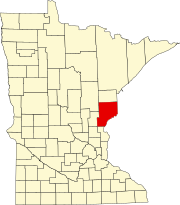Lake Lena, Minnesota
Lake Lena is an unincorporated community and Native American village in Ogema Township, Pine County, Minnesota, United States, located along the Lower Tamarack River.
The community name in the Ojibwe language is Aazhoomog, meaning "Crossroads" in reference to being at the former crossroad of the north–south trail connecting Bikoganaagan (Danbury), via the former Agaming (Outflow/"Lower Tamarack River Village"), and the former Gibaakwa'iganing (Tozer Camp/"lower Upper Tamarack River Village") with the east–west trail connecting Mooningwanekaaning (La Pointe), via Namekaawa'iganing (Gordon), with Gaa-zhiigwanaabikokaag (Hinckley).
Before the arrival of the Dakota Sioux, the area about Lake Lena was inhabited by the Cheyenne, Fox and Ho-Chunk, with migratory Gros Ventre, Mandwe and Menominee peoples.
The Lake Lena area served as a place abundant with food, in the heart of the Folle Avoine Region, with Wild Rice and Sturgeon.
With the arrival of the Ojibwe from the cultural center in La Pointe, the area about the upper St. Croix River became a contested place.
After the Ojibwe had gained control of the upper St. Croix River valley, the Lake Lena area became one of many network of trade villages.
However, in the 1825 First Treaty of Prairie du Chien, the United States formally drew the boundaries separating the Dakota and the Ojibwe.
After the Sandy Lake Tragedy, the United States encouraged the consolidation of the Ojibwe onto Indian Reservations rather than removing them west of the Mississippi River.
Due to strong lumber interests, the Manoominikeshiinyag Ojibwe knew the removal to a reservation would mean eventual loss of hunting, fishing and gathering rights promised the 1837 and 1842 treaties.
